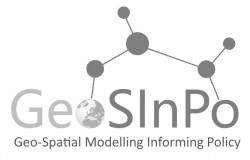Integrated Geo-Spatial Modelling Informing Regional and Urban Development Policy Decisions
Policy makers are facing challenges of managing complex urban and environmental systems influenced by global factors. These factors include as population growth, migration, recession, climate change as well as actions by local actors such as parties or companies who direct the development according to their own vested interest which may not conform with a broader public interest. Confronted with such complexity, decision makers need adequate tools to better understand and evaluate the effects of policy interventions in urban regions. Such pressures led to the development of numerous models covering different discipline-specific areas. Nevertheless, the interconnected character of human and natural systems such as demographics, transportation, infrastructure, economics, land cover, climate, air and water requires an integrated approach in both decision making and modeling. Developing a new comprehensive model integrating various disciplines would be a costly and time-consuming process. Instead, GeoSInPo project led by Marie Sklodowska-Curie Research Fellow Dr. Harutyun Shahumyan focuses on how to best combine existing discipline-specific tools and independent models to devise a quick and effective solution to generate integrated models for different urban regions. The model coupling approach developed in the project aims to make integration of existing models easier, overcoming challenges such as differences in programming languages, unavailability of the source codes or licensing restrictions. The approach was successfully applied at: 1. The National Center for Smart Growth (http://smartgrowth.umd.edu(opens in new window)) at University of Maryland for the Baltimore-Washington Region coupling five independently developed models including land use, transportation, building and mobile emissions and land cover; 2. The School of Architecture, Planning and Environmental Policy (http://www.ucd.ie/apep(opens in new window)) University College Dublin for the Greater Dublin Region coupling independently developed land use and water quality models. The integrated suites include several useful socio-economic indicators, covering: population and employment, transport flow, land use, emissions from buildings and traffic, water quality. The results of these two case studies are promising. The independently developed models smoothly exchange data in a single modelling platform, allowing non-technical users to focus on analysis and results. Moreover, this approach allows adding new models relatively easily; and the works are currently under progress to enhance the Baltimore-Washington Region modelling suite with water quality and habitat models. The source codes and supporting documentation generated by GeoSInPo are published publicly and available for other researchers, enabling the approach to easily be applied to other models for other regions. From a scientific perspective, the work is set to significantly contribute to global understanding of human activity and environmental linkages in urban areas, enabling improved policy development and decision-making focused on ensuring urban sustainability. More details on the project as well as relevant publications and podcasts are available in the project website at: http://geosinpo.shahumyan.org(opens in new window).
Keywords
Countries
Ireland, United States



